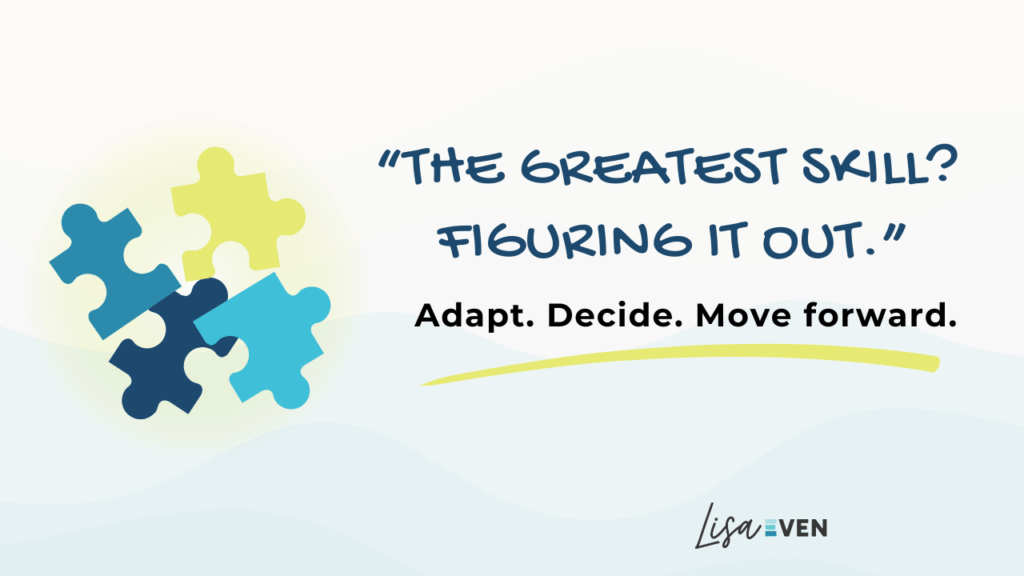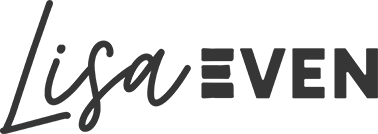
“The greatest skill you can learn is the ability to figure it out.”
In both life and leadership, the ability to figure it out…to think critically, adapt in the moment, and move forward when the playbook runs out…is one of the most valuable skills we can build.
Here are a few ways to build that skill.
LEADERSHIP: The Art and Skill of Figuring It Out
That phrase is deceptively powerful. In today’s fast-moving, ambiguous world, the difference between teams that thrive and those that stall isn’t task execution, it’s how well they navigate the unknown.
I once brought this lesson to life for my team by staging a “mock flight” during a morning huddle. Dressed like a flight attendant (black dress, plastic wing pin straight from my son’s toy box), I welcomed everyone aboard with drinks before sharing a story from Jim Collins’ Good to Great.
Collins describes a pilot who follows strict procedures during takeoff and landing, but mid-flight, when faced with a storm, must rely on judgment, adaptability, and critical thinking. Checklists and training prepare them, but in turbulence, it’s their ability to interpret, decide, and act under pressure that keeps everyone safe.
The same is true in leadership. Systems, tools, and procedures are vital, but real crises rarely come scripted. Teams must learn to “fly through the storm” by building the muscle to reason, adapt, and move forward, even when the answer isn’t obvious. Leaders can’t be everywhere solving or saving the day.
I told my team, “We are all pilots. There are moments where we must follow procedure, and moments where we do the best we can with what we have. Moments where we won’t have guidance from leadership, where we’ll have to fly the plane and figure it out. And that takes practice.”
Why This Matters in the Workplace
I’m sure you feel this too:
- Ambiguity is the default. Real challenges don’t come with a manual.
- Tools don’t replace thinking. Overreliance on systems can dull judgment.
- Empowered problem-solvers free leaders. Independent teams prevent bottlenecks.
- Resilience under pressure. Calm, clear thinkers are invaluable in uncertainty.
One of the simplest ways I build this skill is by asking questions back—it’s real-life practice. When someone brings me a problem, I’ll respond with:
- “What do you think we should do?”
- “What’s your gut say?”
- “What’s the risk if we go that way?”
This shifts the focus from me handing over an answer to them building confidence, critical thinking, and independence—so when they’re the ones “flying the plane,” they’re ready.
Yes, it takes curiosity, time, and patience…but it ensures the team develops the skills necessary to do their jobs well.
Practical Ways to Build the Figure-It-Out Muscle
Technique
What It Develops
How to Use It
Reverse Deconstruction
Outcome-focused thinking
Ask: “If success is X, what 3 steps would get us there?”
Premortem
Anticipating roadblocks
Before action, brainstorm how it could fail and guard against it.
Shadow Decision Walkthroughs
Exposing hidden reasoning
Have a teammate walk you through their past decision process.
No-Answer Drill
Comfort with ambiguity
Pose a problem without tools or systems and force creative reasoning.
Failure Post-Mortem
Learning from imperfection
After decisions, ask: “What assumptions were wrong? What did we miss?”
At the end of the day, the greatest skill we can help our teams develop is the ability to figure it out—because that’s what sustains progress when storms hit.
LIFE: Figuring It Out at Home
This lesson isn’t just for work. As a parent of middle schoolers, I see it daily. Whether it’s harder tests, new chores, or learning to drive, they’re being asked to figure it out more often.
And yet, technology makes it tempting to skip the process. Google, Siri, ChatGPT…answers are everywhere. It’s both amazing and dangerous: amazing because knowledge is at our fingertips, dangerous because it can weaken our figure-it-out muscle.
The challenge is not letting shortcuts rob us of the growth that comes from wrestling with problems ourselves.
I use the same techniques (though more casually) with my kids—asking them questions, giving them space to think it through, and letting them practice being the pilot.
I’m hopeful, though. At work and at home, the real value isn’t just in finding the answer, it’s in developing the persistence, creativity, and judgment that come from figuring it out.
Want Lisa’s weekly blogs delivered to you via email? Sign up here!
